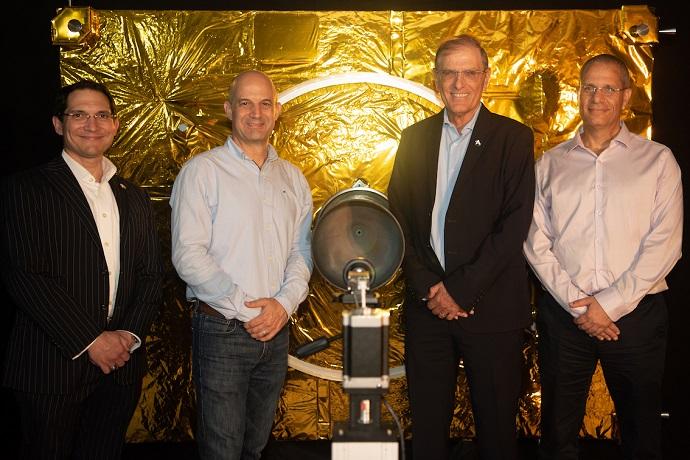Astroscale Israel has opened a laboratory that includes a clean room for the mechanical design, production and assembly of standard (ISO 7) space systems. This is the first clean room in a private Israeli space company and is expected to advance Astroscale ahead of its satellite launch in 2025. The move is expected to advance the Israeli space industry as a whole – as Astroscale intends to lease its laboratory to other Israeli space companies. At the same time, the company inaugurated a robotic computer vision laboratory that will be used to develop and test algorithms for locating and docking satellites in space. The two new facilities are located at the company's offices in Tel Aviv. In order to staff them, Astroscale Israel announced that it intends to increase its workforce, which currently stands at about 40 employees, by tens of percent.
Extending satellite life and saving money
Astroscale Israel is a subsidiary of Astroscale International. In 2020, Astroscale acquired Effective Space, founded by Arie Helzband, and today the company is affiliated to Astroscale USA.
Astroscale Israel develops life-extending satellites for communications satellites, mainly in geosynchronous orbits. "To keep on track, satellites need fuel," explains CEO Arie Helzband. "When they run out of fuel, they start drifting, stop functioning as communications satellites and start disturbing neighbors – that is, they become space debris. Our LEXI satellite is designed to keep the satellite on track.
The LEXI is connected to the old communications satellite, and in practice serves as an external engine – thus extending its life rather than spending tens of millions of dollars on the development and launch of a new satellite. The LEXI uses highly efficient electric propulsion – the thrust to mass ration is at least five times more efficient than conventional chemical fuel – and it can extend the life of a communications satellite by 15 years. As communications satellites also get older, we estimate that most customers will not want to extend their life by 15 years, but by 2 – 3, so one LEXI satellite can service an average of five satellites. The first LEXI satellite is expected to be launched in 2025, on a SpaceX Falcon 9 launch rocket”.

"A leap forward for the entire new Israeli space industry"
LEXI’s biggest technological and engineering challenge will be docking in space. To this end, Astroscale Israel have established the robotic laboratory adjacent to the company's offices. In the laboratory, there is a true-scale model of the docking hatch of a communications satellite, illuminated by a spotlight that simulates sunlight. A robotic arm mounted with a camera repeatedly approaches the "satellite", each time from a different angle and height, in an attempt to connect with it successfully – with Astroscale engineers and programmers sitting in the background trying to test the optical sensor and image processing algorithm.
But long before the LEXI satellite attempts to connect to a communications satellite in space, it needs to be constructed. As a rule, components sent into space are manufactured and assembled in clean rooms. “Space is a very different environment from Earth” explains Helzband. “One problem is the liquids that would only evaporate here on Earth at very high temperatures, evaporate in space even at normal temperatures. Grease, for example, which lubricates the various mechanical parts, can evaporate when exposed to a vacuum. And the second problem is that particles of dirt float from their surface and migrate to places where we really do not want them to go. In LEXI’s case, as the optic sensor is a lens exposed to space, it will be colder than the rest of the satellite, and all the dirt will migrate there because of the differences in temperature. That is why we need to assemble our satellite in a room that is as clean as possible”.

The clean room that AstraScale Israel has inaugurated is a hermetically sealed, controlled environment. Special air conditioners clean the air and maintain a constant level of humidity. In addition, the atmospheric pressure inside the clean room is slightly higher inside than in the offices – so outside air never gets inside. Access to the clean room is through an air lock, in which the engineers wear sterile protective equipment. Finally, the room is darkened and with ultraviolet light they search for dust particles and dirt left on the various surfaces.
“Both the new laboratory and the clean room facility constitute a leap forward in Israel’s commercial space industry," concludes Helzband. "From now on, we can design and build, here on our own premises, mechanisms and systems designed for use in space. Beyond demonstrating technological capability and the use that will be made of products developed and manufactured in Israel, in next-generation space cleaning satellites, we will also allow other space companies access to our facilities. Most of the new space companies that are emerging in Israel today do not have access to such infrastructure, and we will allow them to manufacture and assemble their products here – for the benefit of developing the entire Israeli space industry."
Clip of AstraScale Israel that shows the new facilities.











